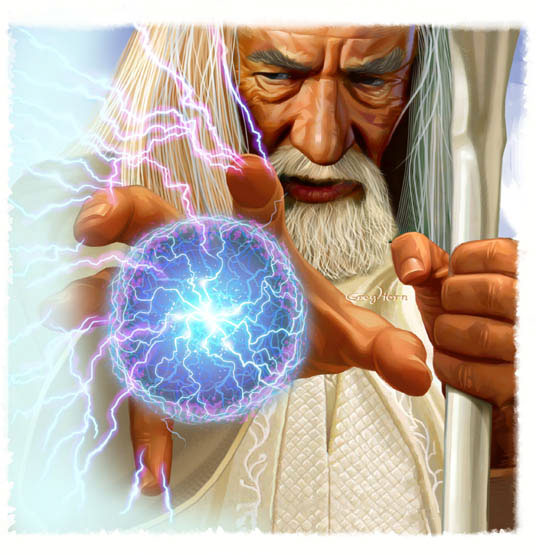Scope: A brief history of where we have been
...
Definition: Printed
Circuit Board (PCB) or Printed Wiring Board (PWB)
 "
Printed circuits were developed during World
War II by the National Institute of Standards
and Technology for use in the
proximity fuze for artillery shells.
Subsequently the printed circuit found wide use
in communication equipment, such as television
and radio receivers, radar, and hearing aids,
computers, and in instrumentation for guided
missiles and airplanes." - Microsoft® Encarta®
Online Encyclopedia 2000 http://encarta.msn.com
© 1997-2000 Microsoft Corporation. All rights
reserved. "
Printed circuits were developed during World
War II by the National Institute of Standards
and Technology for use in the
proximity fuze for artillery shells.
Subsequently the printed circuit found wide use
in communication equipment, such as television
and radio receivers, radar, and hearing aids,
computers, and in instrumentation for guided
missiles and airplanes." - Microsoft® Encarta®
Online Encyclopedia 2000 http://encarta.msn.com
© 1997-2000 Microsoft Corporation. All rights
reserved.
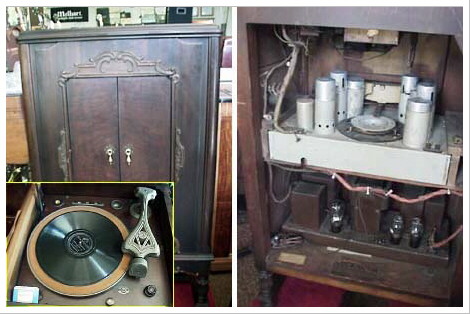
" In the early days of radio and up to the
end of World War II, radio receivers
consisted of resistors, capacitors,
inductors (coils), and electronic tubes
joined together by wires with coloured
insulation. A colour code, whereby a
particular colour was assigned to a
particular circuit connection, such as black
leads for filaments, green for grid, was
adopted throughout the world to facilitate
manufacture and the tracing of faults.
Later, wires cut to the right length were
laced together into a harness to speed
assembly. Plugs and sockets were employed
for connecting one major part with another.
Printed circuit wiring, developed during the
1940s, eliminated much of the hand work and
produced important manufacturing economies.
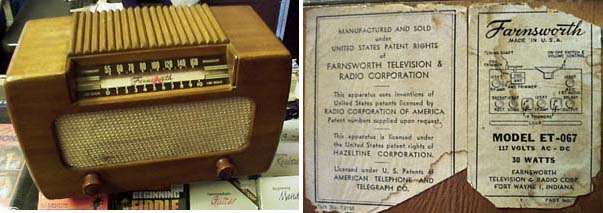
With printed wiring, the layout of the
circuit is planned with component size and
position in mind, and connections are made
by suitably shaped copper strip or foil
bonded to an insulating board or substrate.
An extension of this technique was the
printed component; resistors, capacitors,
and low value inductors became a part of the
printing process.
The development of the transistor simplified
the exploitation of printed circuitry by
eliminating one of the bulkiest components,
the vacuum tube. Further development led to
the manufacture of the integrated circuit in
the 1960s. Compact circuits of this type can
perform a multiplicity of tasks such as
amplification and switching. They are widely
used in computers where space is at a
premium. Integrated-circuit amplifiers are
likely to become more important because of
their ability to amplify very high
frequencies."- Encyclopedia Britannica
Printed Circuit Board -
" Electrical device in which the wiring and
certain components consist of a thin coat of
electrically conductive material applied in
a pattern on an insulating substrate by any
of several graphic art procedures. After
World War II, printed circuits replaced
conventional wiring in much electronic
equipment, such as radio and television
sets, computers and control equipment, and
airborne and guided-missile electronic
systems. They greatly reduced the size and
weight of the equipment while improving
reliability and uniformity over the
hand-soldered circuits formerly used.
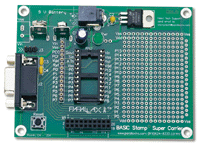
Of the many techniques of manufacture, most
involve photoetching or stencil etching. The
insulating board is coated with copper and a
protective film is deposited,
photographically or by silk-screening, in
the pattern desired for the circuit. The
unprotected copper is then etched away
either in an acid bath (for photographically
deposited film) or by stencil-etching
methods (for silk-screen film). The
remaining conductive copper is left intact
in the pattern of the circuit." -
Encyclopedia Britannica
My experience with PCB design goes back to
the late 1960's and early 1970's. My father
ran a PC Board manufacturing business in
Vista, CA called Commercial Electronics
Services. We made 'short run' proto boards
for Hughes Aircraft Co. (and others) for
about 5 years while I was still attending
High School and training to become an
electronics technician. I took Electronics I
and II in High School from a great
instructor, Mr. Vito Busalacchi, and made a
PCB design by drawing on a copper clad board
using a resist pen and etched it with
FERRIC CHLORIDE (FeCl3·6H2O)
in class. Later, after etch and rinse and
resist removal with cleanser, I drilled
holes in the board to mount the axial and
radial leaded components to the board by
soldering the leads to the etched circuit.
Later, when I started working at my dad's
shop, I was introduced to KPR,
Kodak Photo Resist, a light sensitive
colorless liquid that was applied to the
surface of the copper laminate to
'sensitize' it to the image of the circuit
we needed to print on the board. This gave
us an accurate reproduction from an
orthographic film (2 color, black or opacity
and clear or translucent.. no gray
color)...(A major improvement over
hand drawing..) and we used triclorethelyne,
(a solvent ) as a developer... (now a banned
substance due to the cancer risk)... And we
etched the boards with
AMMONIUM PERSULFATE (NH4)2S2O8
w/ 10cc of MERCURIC
CHLORIDE (HgCl2)
per 10 gallons of etchant. (Note..these
chemicals were not as tightly controlled or
the hazards as well known as they are
today...see safety sheets
below in the notes. There are newer safer
more environmentally responsible methods of
etching PCB's today. ) This gave us
a fast etch and a very clean board image in
copper. We then drilled the holes in the
board with a
Precision Drill Press made by Cameron using the pad centers as guides and
trimmed the boards to shape with routers and
sheet metal shears
made by Diacro and shipped
them. It was a good experience, one that has
served me well through my career as a
designer.
Printed Circuits were developed to take the
place of the 'BREADBOARD'. (Where exactly
that term came from I can't answer...)
But... here is a definition I found on the
web...
Breadboard - A hand-made system
prototype built as a proof of concept. In
the early days of electronics (even before
transistors were invented), engineers
actually mounted circuit components on
blocks of wood; hence the term "breadboard."
( I imagine the use of your families'
breadboard (or cutting board) in the
kitchen was not uncommon...? Although,
my mother would have killed me if I had used
her breadboard to prototype my audio
amplifier circuit...)
Suffice it to say that most electronic
circuits were developed by using a
perforated board with holes at 100 mil
centers or some even distance that you could
put 'push terminals' into to mount
electronic components to. In my electronics
class we built a
superheterodyne tube type radio receiver
as one of our projects completely without
the use of any printed circuits. We wired up
the radio using terminal strips and tube
sockets. Some guys were real creative and
made what we called 'air sculpture' with
their circuits. (This was a sort of
disorganized tangle of wires that was
difficult to even see through, let alone
trace.)
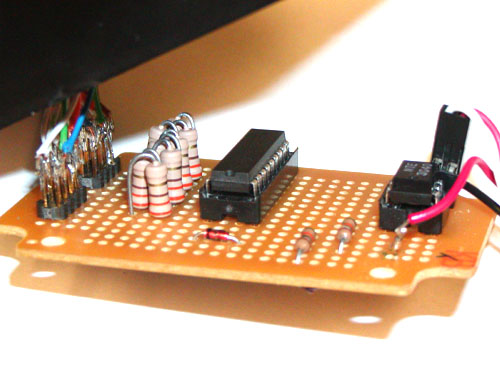 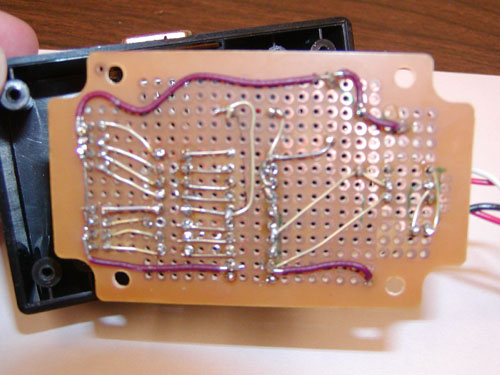
We also breadboarded a 400VDC power
supply...which is where I found out about
stored electrical charges in large
capacitors the hard way...(ouch) but that's
another shocking story. We were taught to
wire the many connections by bundling the
wires into harnesses and routing the
harnesses in such a way to make test and
troubleshooting easier. It was fairly time
consuming, but made you realize the benefits
of being organized in the building process.
Neatness really makes a difference when you
have a bad connection and are trying to find
it with an ohm meter.
Now, these kinds of things can be fun to
build as a one time project, but if you
wanted to make thousands of them, as I'm
sure you can see, the labor costs would be
greater than what you could sell the device
for... thus making it an impractical
product. That's why we make PCB's. Cost,
reliability, serviceability, labor
savings....the main benefits of using
printed circuit boards for electronics.
So, to put it in a nutshell, Printed and
Etched Circuit Boards were invented to make
a repeatable, mass produced, cost effective,
electronic product. The etched copper
on the board takes the place of all those
wires that were in the prototype model that
was 'breadboarded' by the technician or
engineer. Thus reducing the cost to go to
market with their electronic gadget...like a
cell phone, stereo, tv or computer, etc.
- Bill Brooks
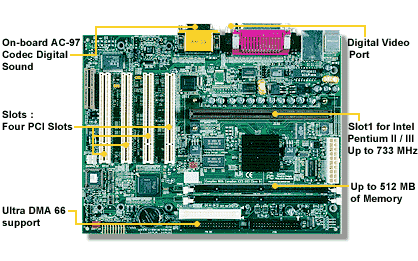
A Modern Computer Printed Circuit
Board Assembly

Notes:
KPR
1953 - The company introduced KODAK Photo
Resist, designed for making photolithographic
printing plates; the business was sold to Union
Carbide Corporation in 1987. A new subsidiary,
Eastman Chemical Products, Inc., was formed to
market products made by Tennessee Eastman and
Texas Eastman.
Proximity fuze - Date: 1945 - a fuze
for a projectile that uses the principle of
radar to detect the presence of a target within
the projectile's effective range
- Merriam Webster's Collegiate Dictionary
Ferric Chloride Safety Sheet
Ammonuim Persulfate Safety Sheet
Mercuric Chloride Safety Sheet
su·per·het·er·o·dyne
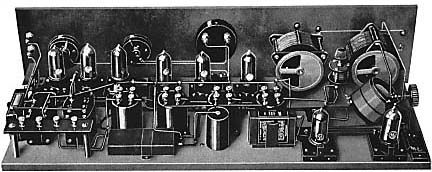
A form of radio reception in which the
frequency of an incoming radio signal is
mixed with a locally generated signal
frequency (L.O. or local oscillator) and
converted to an intermediate frequency (I.F.)
in order to facilitate amplification of the
preferred frequency and the rejection of all
other unwanted signals. Based on an
ancient Chinese principle called 'Ning'
applied to 2 frequencies (Tu) thus we get
Tu-Ning or tuning... :-)
(sorry, I couldn't help myself.., the last
part is a joke..in case you didn't know)

Old folks - Respect them!
A very
self-important college freshman attending a
recent football game, took it upon himself to
explain to a senior citizen sitting next to
him why it was impossible for the older
generation to understand his generation.
"You
grew up in a different world, actually an
almost primitive one." The student said,
loud enough for many of those nearby to
hear.... "We, the young people of today, grew
up with television, jet planes, space travel,
men walking on the moon, our spaceships have
visited Mars. We have nuclear energy,
electric and hydrogen cars, computers with
light-speed processing and...," pausing to
take another drink of beer.
The Senior
citizen took advantage of the break in the
student's litany and said, "You're right,
son..."
"We didn't
have those things when we were young." he
pause... "So we invented them!"
Now, you
arrogant little !$%,... What are YOU DOING
for the next generation?"
The applause
was resounding... I just love senior
citizens. :-)
|
